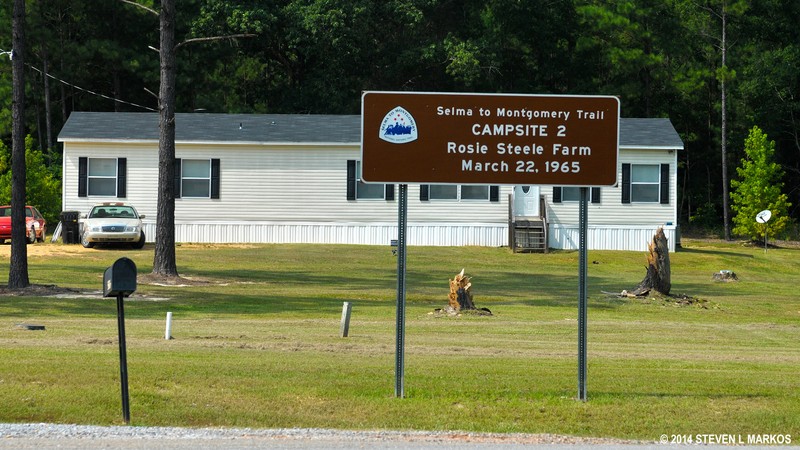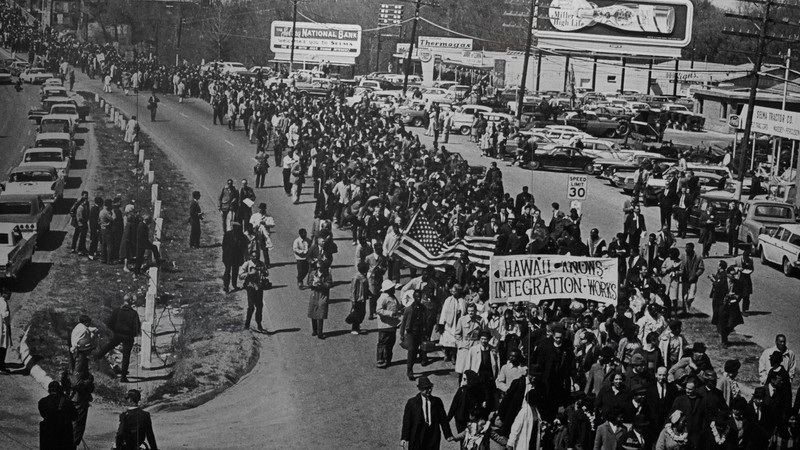Rosie Steele Farm
Introduction
Text-to-speech Audio
Images
After travelling around 10 miles on March 22, 1965, the marchers chose the Rosie Steele farm along Highway 80 as there second campsite.

In March of 1965, Black and white civil rights activists marched for the voting rights of all Americans.

Backstory and Context
Text-to-speech Audio
After travelling approximately 10 miles on March 22, the activists rested at Rosie Steele's farm and had three more days before they would reach the Alabama
State Capitol in Montgomery. The marchers were fighting for voting rights
for all Americans, a right they should have had under the Fifteenth
Amendment. Passed in 1870, the Fifteenth Amendment made it illegal for state governments to ban anyone from voting based on the color of their skin. Despite
the amendment white supremacists in the South found ways to prevent African
Americans to vote; these methods ranged from a literacy test to
intimidation through threats and acts of violence. During the 1960s an
African American could face death if he or she attempted to vote in the South; frequently
you or someone close to you was brutally beaten or killed for trying to vote. The
violence was not limited to African Americans, sympathetic whites
were also victims of violence if they assisted the voting rights efforts in the
South.
While thousands of people came to
Alabama from all over the country to participate in the third march, only a
certain number were allowed in Montgomery on the fifth and final day of the
march. This was a concession Dr. King had to make if he wished to have federal protection for the march. Once the marchers arrived at the Alabama State Capitol, Dr. Martin
Luther King Jr. delivered a victorious and hopeful speech to the crowd. Governor George Wallace was not sympathetic to the crowd and the voting rights struggle continued. However, the sense of victory and hope felt during King's "How Long, Not Long" speech was experienced again on August 6, 1965 when President Johnson signed the Voting
Rights Act of 1965.
While the Voting Rights Act of 1965 made any effort to bar people from their constitutional right to vote illegal, African Americans still had to struggle for their right to vote. However, the act gave African Americans the federal right and protection to fight for this right. While the African American community celebrated this victory in 1965, civil rights leaders and organizations turned their attention to other campaigns to gain further civil rights for African Americans. The outpouring support of the country during 1965 signaled a change in the opinion of the nation. The Selma to Montgomery March brought national attention to the violence that African Americans experienced on a daily basis just for exercising their constitutional rights.
Sources
http://npplan.com/national-historic-trails/selma-to-montgomery-national-historic-trail-trail-at-a-gl...
"Rosie Steele Farm Campsite." Alabama's Front Porches: Southwest Alabama Regional Office of Tourism and Film. Accessed on November 7, 2017.
https://www.alabamasfrontporches.org/attraction/rosie-steele-farm-campsite/
National Park Service. Accessed on November 7, 2017.
https://www.nps.gov/semo/planyourvisit/upload/BatesProofs-Rack-Cards.pdf
"Selma to Montgomery National Historic Trail Alabama." nps.gov. Accessed on November 15, 2017. https://www.nps.gov/nr/travel/cultural_diversity/Selma_to_Montgomery_National_Historic_Trail.html
